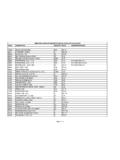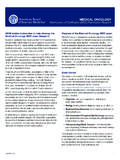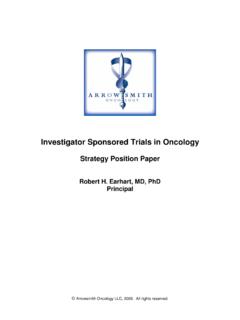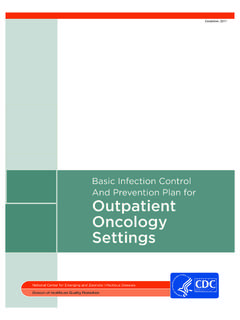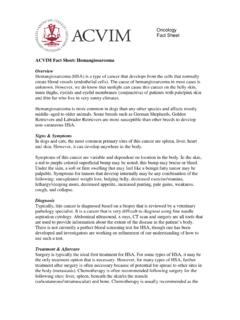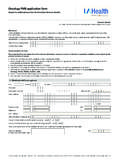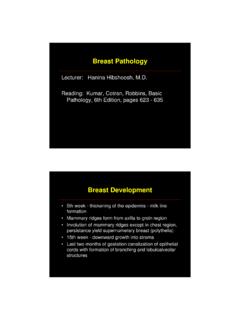Transcription of Registered Nurse The Role of the Oncology
1 The Role of the OncologyRegistered NurseIn Outpatient Medical Oncology The Role of the Oncology Registered NurseIn Outpatient Medical Oncology AAcckknnoowwlleeddggeemmeennttss The Role of the Oncology Registered Nurse in Outpatient Medical Oncology would not have been possible without the input and expertise provided by Eric Berger, Bridget Culhane, Cynthia Fisher, Laura Fennimore, Ilisa Halpern, Kris Hartigan, Gail Mallory, Pearl Moore, Julie Painter, Dianne Richardson, Paula Sherwood, Kathleen Shuey, and Karen Stanley. The Role of the Oncology Registered NurseIn Outpatient Medical Oncology Table of Contents Introduction 1 Section One: Pretreatment 3 Section Two: Treatment 18 Section Three: Additional Clinical Responsibilities 28 Section Four: Oral Chemotherapy 34 Section Five: Case Study 36 Definitions 40 References 44 1 The Role of the Oncology Registered NurseIn Outpatient Medical Oncology IInnttrroodduuccttiioonn A diagnosis of cancer is a frightening and life-changing event.
2 The individual and his/ her family fear the worst as they face the unknown, undergo a variety of treatment options and procedures and experience the side effects of therapy that can alter their quality of life. The impact of cancer on an individual s life correlates with the degree of change and disruption experienced. In today s world, patients in the midst of treatment continue to care for families, work, and face life with the resources that are available. The Registered Nurse s ability to provide patient and family education across the illness and treatment continuum assists patients to adjust to the realities of the illness, cope more effectively, and reduces anxiety. The Registered Nurse s skills in thorough assessment and intervention significantly impact patient outcomes. Research verifies that ongoing nursing communication, assessment, and intervention can reduce readmission rates and assist in the early diagnosis of problems so that patients experience fewer complications.
3 The purpose of this document is to provide information on the unique needs of cancer patients and their families and the responsibility and unique contributions of the Registered nurses who care for them. This document has been developed through a collaborative partnership between nurses representing the Oncology Nursing Society and US Oncology . The mission of both organizations is to promote quality patient care. The document explains and details services that may be provided during the care of the patient and family in an outpatient Oncology setting/facility. Of note are the numerous interventions (such as delivery of chemotherapy/biotherapy, treatment of a disease by means of chemical substances or drugs, and management of side effects of therapy) requiring the unique contribution of the Registered Nurse with Oncology specific training and competencies.
4 Registered nurses enhance quality care by utilizing state-of-the-art knowledge and the skills of assessment, planning, intervention(s), and evaluation and provide the safest environment for the patient and family. Chemotherapeutic agents used for treating cancer are available in various forms. The form (route of administration) may depend on patient capability to receive the medication in that way or the requirements of a specific chemotherapeutic regimen/ treatment plan. Routes of chemotherapy administration include: topical (rubbed onto the skin), oral (by mouth in pill form), intravenous (administered through a catheter inserted into the patient s vein in the arm, neck or chest), intrathecal (administered via a catheter inserted into the patient s cerebrospinal fluid), via ommaya reservoir (administered through a device that allows the medication to enter ventricular spaces in the brain), and intraperitoneal (administered into the peritoneal /abdominal cavity).
5 All routes of chemotherapy require safe and consistent delivery. Many patients will require surgical or radiologic placement of central venous access devices (intravenous devices that are placed into large veins in the upper chest) while other devices such as peripherally inserted central catheters may be placed by a specially trained Registered Nurse into a large vein in the arm. As these devices provide a direct line of infusion to major blood vessels supplying the heart, they 2 The Role of the Oncology Registered NurseIn Outpatient Medical Oncology require meticulous care to prevent infection, regular dressing changes, and intermittent flushing with solutions that prevent the blood from clotting and keep the line open. This document is divided into key sections or treatment phases. Each phase details specific healthcare provider interventions and essential Registered Nurse interventions along the continuum of outpatient medical Oncology care.
6 Section One, the Pre-Treatment phase, addresses interventions prior to the actual initiation of chemotherapy. Section Two, the Treatment Phase, addresses those interventions that occur from the time therapy is initiated until all drug delivery devices (catheters used to deliver therapy into a vein, the cerebrospinal fluid, or ventricular spaces in the brain) are removed from the patient. Section Three, Additional Clinical Responsibilities, addresses interventions that might occur more frequently and/or intermittently across the treatment continuum ongoing education, reinforcement of previously given information, symptom/side effect management, management of intravenous devices, and other issues as they arise, as well as those responsibilities focusing on documentation and telephone triage. Section Four, Oral Chemotherapy, addresses those unique interventions required when patients are self-administering chemotherapy in the home setting.
7 Section Five includes case scenarios with examples of patient treatment experiences and nursing interventions. 3 The Role of the Oncology Registered NurseIn Outpatient Medical OncologyThe following sections describe the responsibilities of the Registered Nurse in medical Oncology and activities associated with caring for patients receiving chemotherapy or biotherapy. Some of the activities described can be performed by clinical staff other than the Registered Nurse ( , a pharmacist) or by technical staff who are supervised by the Registered Nurse . Duties that are exclusively the responsibility of the Oncology Nurse are noted. In addition, the frequency of activity is listed. Activities may occur on the first day of chemotherapy (first visit), at each chemotherapy visit, each time a chemotherapy agent is given by IV push or IV infusion, at each cycle (chemotherapy agents are given for a predetermined time frame [ , a group of chemotherapy agents may be given for three days every 21 days and the patient s response to treatment evaluated at the end of each cycle]), or some other frequency.
8 SSeeccttiioonn OOnnee:: PPrreettrreeaattmmeenntt Requires Registered Nurse First Visit Each Visit Each IV Push Each Infusion Each Cycle As Needed Patient assessment: physical and psychosocial. Comprehensive physical assessment: X X X History and physical examination (determines current condition). X X X Review of systems: head and neck, skin, respiratory, cardiovascular, gastrointestinal, genitourinary, musculoskeletal, lymph nodes and related swelling, blood cells, nervous system, and particular body chemistries. X X X Coexisting health problems ( , cardiac history, diabetes, emphysema). X X X Current allergies to medication, food, and environmental factors.
9 X X Nutritional status. X X X Review and update medication list and check for incompatibilities or drug interactions. Discuss potential interactions with physician and/or pharmacist to determine if changes need to be made. X X Currently prescribed medications. X X Over-the-counter medications. X X 4 The Role of the Oncology Registered NurseIn Outpatient Medical OncologySSeeccttiioonn OOnnee:: PPrreettrreeaattmmeenntt Requires Registered Nurse First Visit Each Visit Each IV Push Each Infusion Each Cycle As Needed Complementary and/or alternative medications or therapies.
10 X X Obtain and review laboratory results to determine if they are within an acceptable range as set by the practice. Chemotherapy destroys rapidly dividing cells, both normal (hair follicles, lining of the gastrointestinal tract, reproductive tract, and blood cells) and malignant cells. Assess laboratory values in light of expected side effects ( , decreased blood counts) and unanticipated complications of previously administered therapies. Alert the physician regarding laboratory results that may impact the chemotherapy regimen. X X X Examples of laboratory values may include: Complete blood count: white blood cells that fight bacterial and viral infection, red cells that carry oxygen to the body and help with fatigue problems, and platelets that assist with clotting.
